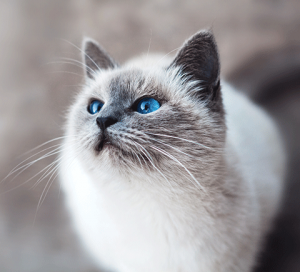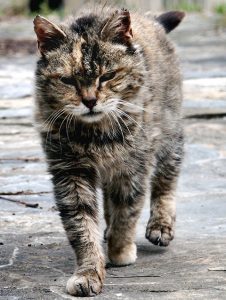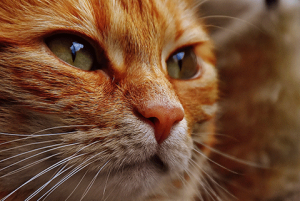We all want our pets to be as healthy as possible – and therefore, to keep them safe from illness and disease. However, with the internet, there’s now a lot of information easily available, and it can be really hard to decide what’s in our animals’ best interests. In this blog, we’re going to look at the basics of preventative healthcare for cats – ways that we can prevent problems from starting, rather than trying to react and fix them once they have developed. 
Vaccination has probably saved more lives than any other medical intervention in the last 150 years (except possibly sanitation/freshwater). That goes for animal diseases as much as for human ones – but recently some people have started to question how useful, or even how safe, it is. So, we’ll start off by looking at cat vaccines.
How does a vaccine work?
Although the exact mechanism is really quite complex, in principle, a vaccine teaches the cat’s immune system how to fight an infection, without putting the cat at risk of contracting the disease.
To do this, either a weakened form of the disease-causing organism (an ‘attenuated’ vaccine), or a dead organism (a ‘killed’ or ‘inactivated’ vaccine, usually containing an ‘adjuvant’ – a chemical to trigger the immune system to respond to a dead organism) is introduced into the body. There are also ‘recombinant’ vaccines where a harmless bug (e.g. canarypox virus, which can only cause disease in canaries) is genetically modified to vaccinate the cat against another virus, without causing any different disease. The immune system will recognise it, and take the next week or so learning how to fight it. This means that, when presented with the challenge of the ‘real thing’, the cat’s immune system can jump on it straight away, without that 4-7 day lag phase.
What can we vaccinate against?
The core vaccines we recommend are:
- Feline Panleukopenia Virus (P), FPV; a nasty infection, related to Parvo in dogs, which breaks down the cat’s intestinal lining; at the same time, it attacks their immune system. The symptoms include bloody vomit and diarrhoea, shock, collapse and, in up to 90% of cases, death; unfortunately, the virus can survive for many months in the environment and can be carried into the house on clothing, shoes etc., so even a house cat isn’t safe. Vaccination is highly effective, and has been proven to last a minimum of 3 years in the vast majority of cats. You can learn more about this disease here. Vaccine protection lasts for at least 3 years once the primary course is complete.
- Feline Herpesvirus (FHV) or Feline Rhinotracheitis (R); one of the causes of Cat Flu, a highly contagious respiratory infection in cats. Cat Flu is very rarely fatal, but is persistent – once infected, a cat with herpesvirus is likely to remain infected for life. As well as upper respiratory disease, it can cause reoccurring eye ulcers or dermatitis, and is similar to herpes viruses in people, in that it lives in the nerve cells and can be reactivated at times of stress. Fortunately, the virus only survives a few days in the environment, so passive spreading of infection is less common. Read more here.
- Feline Calicivirus, FCV (C), the other major cause of Cat Flu, this virus generally causes slightly less severe symptoms than herpes, but can also lead to chronic stomatitis (inflammation of the mouth), arthritis (joint inflammation), and can occasionally mutate to cause life-threatening disease (Virulent Systemic FCV). Infected cats may shed the virus for weeks or even months before clearing it, but do not usually become persistently infected as with FHV. Like the FHV vaccine, full protection from the vaccine lasts a year.
Recommended for cats in multi-cat households and those with outdoor access
- Feline Leukaemia Virus, FeLV; is a very important viral infection that can lead to severe immunosurpression, anaemia and/or cancer in chronically infected cats. It has been estimated that 80%-90% of infected cats die within 3-4 years of an FeLV diagnosis. It requires direct contact between cats to spread, therefore solitary indoor cats are not at the same risk as cats who go outdoors, or who live in multi-cat households. Please discuss with your vet whether it is indicated for your cat.
Please read here for further information.
When should I get my cat vaccinated?
The primary course consists of two vaccines, 3-4 weeks apart (from 8-9 weeks of age and then a booster at 12 months after the kitten course, usually at 15 months of age).
If you have rehomed an adult cat, please ask for a vaccination history and if you have no history, please make an appointment with one of our vets to discuss potentially testing for FeLV (and FIV which is another chronic viral infection in cats) and recommendations for an adult booster course for your cat.
After the primary course, we recommend yearly vaccination against the Flu Viruses (RC) and then every 3 years against Panleukopenia (P) and FeLV
There are also vaccines available against Rabies (only needed if you intend to take your cat abroad), and Chlamydophila (Feline Chlamydia, another cause of Cat Flu, only usually necessary in catteries or breeding colonies).
What are the risks?
There is no such thing as a medicine without side effects – if a drug cannot produce side effects, it probably means it isn’t actually doing anything. However, the vast majority of these are very mild, typically lethargy, mild inappetence or itchiness and discomfort at the injection site, lasting 24 hours or so. These are not signs of a problem – they mean that the cat’s immune system is ‘fighting’ the vaccine, which is what we want to happen!
Rarely, cats may develop more marked symptoms – sometimes vomiting, diarrhoea, lameness, fever or a transient lump at the injection site. These are usually signs of the same immune activation, but more pronounced. None of these are likely to cause long-term or serious problems for your cat but if you have any concerns, please contact your vet practice.
In the past there has been a potential link between vaccination and chronic kidney disease (CKD). Further studies have not shown a link between annual vaccination and CKD, however it is advisable to avoid unnecessary overuse of vaccines and we recommend that some parts of the vaccine are given only every three years.
Another rare adverse effect is the Feline Injection Site Sarcoma (FISS). Rarely, some cats develop an invasive cancer at injection sites with a possibly increased risk associated with FeLV vaccinations and Rabies vaccination. Therefore we recommend only giving FeLV vaccination every 3 years and to risk assess indoor cats to see if they are at risk of infection and whether vaccination is indicated.
To read more on this, please see the World Small Animal Veterinary Association (WSAVA) Guidelines for the vaccination of dogs and cats.
Does vaccination outweigh the risks ?
The World Small Animal Veterinary Association has concluded that while the risk of FISS is a serious consideration, the benefits of vaccination in preventing life-threatening diseases outweighs the risks.
Natural infection with FeLV, for example, results in more than half of infected cats dying within 3 years; FeLV vaccine reactions are far, far rarer than this (reportedly less than 0.1% of cats developing any side effects that needed treatment); and between 1 and 2% of all UK cats are carrying FeLV and are potentially contagious.
Herpes Virus is a very common virus in cats with estimates that 50%-90% are carriers across the world. Vaccination can help reduce the frequency and severity of symptoms in affected cats. As stated, Feline Panleukopenia is rare, but highly fatal in cats.
It is true that many cats who contract infectious diseases will survive them even if not vaccinated. However, this doesn’t take into account the large number of cats who, even if they are a minority percentage wise, are still loved and would be missed by their owners and families if they were to die of a preventable disease. Natural infections may also result in chronic ill-health, unnecessary suffering for the pet and these infections can be very costly to treat. The only reason that these diseases are as rare as they are is because of widespread vaccination, which gives some protection even to unvaccinated animals, by impeding the spread of the diseases through the population.
What about testing the cat to see if they’re immune before vaccinating?
This is a protocol sometimes called titre testing, and it can work for some vaccines. However, it is not able to say when immunity will drop subsequent to the testing, or timing of future vaccination.
Unfortunately, titre testing is only available for Feline Panleucopaenia in cats. It may be desirable if your cat is immunosupressed due to treatment or chronic illness. If you want to go down this route, please speak with one of our vets for advice.



